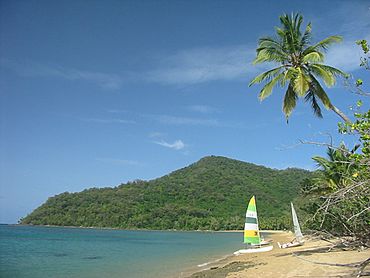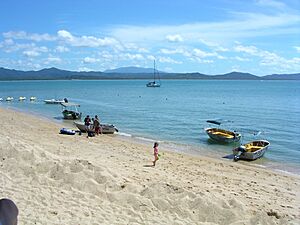Dunk Island facts for kids
Quick facts for kids Dunk Island(Coonanglebah) Queensland |
|
|---|---|

Mount Kootaloo behind Brammo Bay
|
|
| Area | 10 km2 (3.9 sq mi) |
| State electorate(s) | Hill |
| Federal Division(s) | Kennedy |
Dunk Island, also known as Coonanglebah in the Warrgamay and Dyirbal languages, is a special island in Queensland, Australia. It's about 4 kilometers (2.5 miles) off the east coast, right across from Mission Beach. This island is part of the Family Islands National Park and is also within the amazing Great Barrier Reef World Heritage Area.
The island is surrounded by colorful reefs and is home to many different kinds of birds. Long ago, the Bandjin and Djiru peoples used the island to find food. Europeans first settled here in 1897. During World War II, the Royal Australian Air Force used Dunk Island. In recent years, the island and its resort have been damaged by strong storms called Cyclone Larry and Cyclone Yasi.
Contents
Exploring Dunk Island's Nature
Dunk Island is the biggest island in the Family Islands National Park. All the islands here are made of granite rock. Thousands of years ago, these islands were actually connected to the mainland! Dunk Island is about 970 hectares big. Most of it (730 hectares) is a national park, which means it's protected. The island has sandy beaches, rocky shores, gentle slopes, and even steep, rugged areas. Mount Kootaloo is the highest point, standing 271 meters (889 feet) above the sea.
Birds and Other Animals
More than 100 types of birds live on Dunk Island, including some rare ones. In summer, terns and noddies come here to lay their eggs. It's a perfect spot because there aren't many predators, and there's lots of food from the nearby reefs. You can also find pythons, tree snakes, geckos, and skinks on the island.
The waters around Dunk Island are full of marine life. You might see sea turtles, dugongs, sharks, corals, fish, shellfish, and crabs. A small island nearby, Purtaboi Island, is closed from October to April. This is because crested terns nest there during those months.
Dunk Island's Past
Early Days of the Island
The original Aboriginal people of Dunk Island are the Bandjin and Djiru people. They have lived in this area for tens of thousands of years. After the sea level rose, they would paddle to the islands in bark canoes to gather food and supplies. The Warrgamay and Dyirbal name for Dunk Island is Coonanglebah, which means "The Island of Peace and Plenty."
The island got its European name from Lieutenant James Cook. He sailed past it in his ship, the Endeavour, on June 8, 1770. He called it Dunk Island after George Montague-Dunk, 2nd Earl of Halifax.
Europeans started settling the nearby mainland in the 1800s, looking for gold, wood, and land for farming. In 1848, John MacGillivray studied the plants and animals on the island. This was when the ship HMS Rattlesnake was anchored there for ten days. He later wrote about the island's nature in his book, Narrative of the Voyage of HMS Rattlesnake, published in 1852.
Edmund Banfield's Island Life
In 1897, a writer named Edmund James Banfield was very tired from work and not feeling well. Doctors told him he only had six months to live. So, he moved to Dunk Island with his wife, Bertha. They became the first white settlers on the island. Banfield had been a journalist for 15 years. He found peace on the island and lived there for 26 more years until he passed away in 1923.
The Banfields first lived in a small hut built with help from an Aboriginal man named Tom. They cleared four acres of land to grow fruits and vegetables. With their chickens, cows, and goats, plus plenty of seafood, they lived a very simple and self-sufficient life. Banfield loved studying Dunk Island's nature. He wrote down everything he saw and published articles about island life. He also wrote a famous book called Confessions of a Beachcomber (1908). This book made Dunk Island famous as a beautiful, faraway paradise.
Banfield wrote more books about Dunk Island, like My Tropical Isle (1911) and Tropic Days (1918). In these books, he shared what he learned about nature and the stories of the Aboriginal people. Edmund J. Banfield died on June 2, 1923. His last book, Last Leaves from Dunk Island, was published after he died in 1925. His wife stayed on the island for another year before moving away. Today, both are buried on the walking trail to Mount Kootaloo.
Resort Begins and World War II
In 1934, Captain Brassey bought the island. Banfield's old bungalow became the start of a new resort. The resort officially opened in 1936. During World War II, the Royal Australian Air Force took over Dunk Island. They built an airstrip in 1941 and a radar station on the highest point in 1942. The radar station was taken down when the war ended in 1945.
Growing as a Tourist Spot
After the war, the Brassey family ran the resort again for a while. Then, the island had several different owners. In 1956, Gordon and Kathleen Stynes bought it. They moved their family there and improved the resort a lot. Dunk Island became a very popular place for famous people, including actors like Sean Connery and even Australian Prime Ministers. The Stynes family owned the resort until 1964.
Later, big companies like Trans Australia Airlines and Qantas owned Dunk Island. In 1997, P&O Australian Resorts bought it, and then Voyages took over in 2004. In 2009, Hideaway Resorts purchased Dunk Island.
Artists' Community
Dunk Island was also home to a small group of artists. They lived, worked, and showed their art to visitors on the southern side of the island. This community started in 1974. Even after strong cyclones damaged many of their homes, one artist, Susi Kirk, continued to live and work on the island. She is the last known member of the artists' community there.
Recent Years: Cyclones and Changes
After Cyclone Yasi hit in 2011, Dunk Island was bought by an Australian businessman, Peter Bond. Plans to rebuild the resort started in 2014, but the redevelopment didn't happen.
In September 2019, an investment group called Mayfair 101 bought Dunk Island. They also bought many properties on the mainland near Mission Beach. They had big plans to bring the area back to life. However, in August 2020, the previous owners took the island back because Mayfair 101 couldn't meet their payment agreements.
Then, in July 2022, Annie Cannon-Brookes, whose husband is Atlassian founder Mike Cannon-Brookes, bought Dunk Island. She reportedly paid between A$20-25 million. Her goal is to protect the island's natural beauty while also developing the resort.
Special Places on Dunk Island
Dunk Island has some important historical sites:
What Dunk Island is Used For
National Park Activities
Dunk Island has 13 kilometers (8 miles) of walking tracks. You can take a short walk to Edmund James Banfield's grave or a longer 4-hour hike around the whole island. Tour companies and the Dunk Island resort also offer guided tours.
Getting There
The Mission Beach Dunk Island Water Taxi and Mission Beach Charters offer rides between Mission Beach and Dunk Island. They also take guests to Bedarra Island.
The Resort
The resort on Dunk Island first opened in 1936. It was very popular, especially with wealthy visitors in the 1960s. It had 160 rooms and was a favorite for families and couples. However, Cyclone Yasi badly damaged the resort in 2011, and it has been closed since then. There are plans to rebuild it with new and improved facilities.
Camping
There is also a camping ground for visitors in the national park. You need a special permit to camp there.
Airstrip
Dunk Island has a small airstrip called Dunk Island Airport. It's near the resort. Before the resort was damaged in 2011, many flights came here from Cairns.
Jetty
Dunk Island has a jetty where the ferry docks. You can also use this jetty for fishing and enjoy views of the water around the island.
Dunk Island's Weather
Dunk Island is in the tropics, which means it's usually warm. The average high temperature is about 29 degrees Celsius (85 degrees Fahrenheit). The island can experience tropical cyclones, which are strong storms. You can read more about past cyclones below.
Big Storms on Dunk Island
Cyclone Larry
On March 20, 2006, Cyclone Larry hit the coast of Queensland near Innisfail. It was a very strong Category 4 cyclone. About 160 staff members and 280 guests from Dunk Island were moved to Cairns for safety. However, 20 staff members stayed on the island. The resort was damaged, but it reopened on July 1, 2006, after about $20 million was spent on repairs.
Cyclone Yasi
Between late February 2 and early February 3, 2011, the eye of Cyclone Yasi passed directly over Dunk Island. It was an extremely powerful Category 5 tropical cyclone. Mobile phone service was lost, and power went out as the storm approached. The resort had satellite phones and generators. Most guests and some staff were flown off the island before the cyclone hit.
Impact on the Resort
The damage to the resort was very severe. Much of it needed to be completely rebuilt. The palm trees, which are usually strong, were stripped bare. The resort's pool was filled with sand from the storm surge, and many buildings were badly damaged or unroofed. The gardens were also ruined.
In July 2012, the island's general manager said that repairs were going slowly. The resort was not expected to reopen for at least another 18 months. The campsites were planned to reopen in September 2012. However, the full restoration was delayed many times. In late 2019, it was announced that a new investment group had bought Dunk Island and planned to rebuild the resort with many new features.
Dunk Island in Pop Culture
Dunk Island has even been featured on TV! In the third season of the reality television show The Mole, contestants had to draw a map of Dunk Island. Also, one of the final scenes in James Cameron's movie Sanctum was filmed on Muggy Muggy beach on the island.
Images for kids









